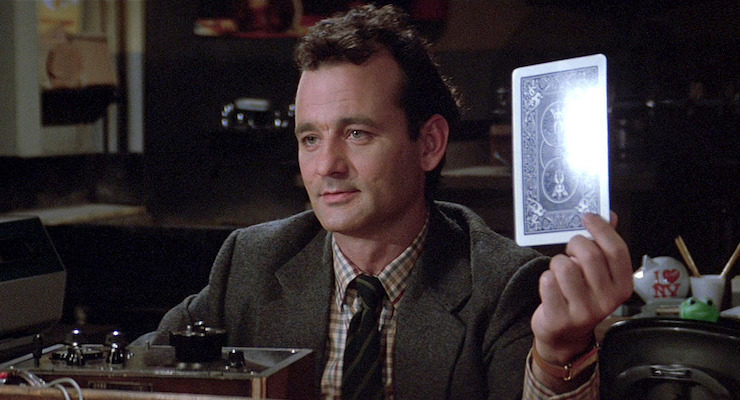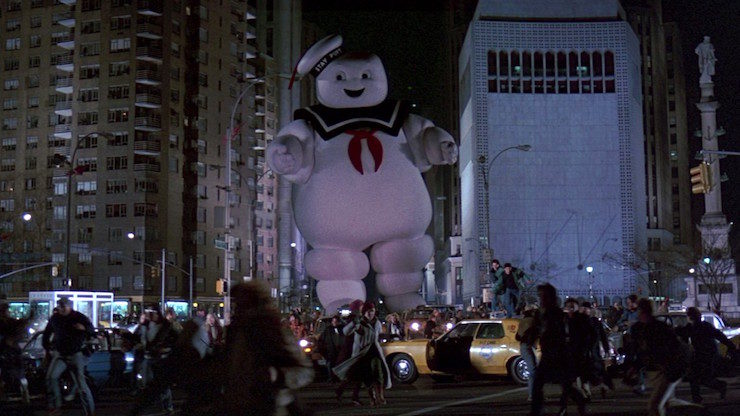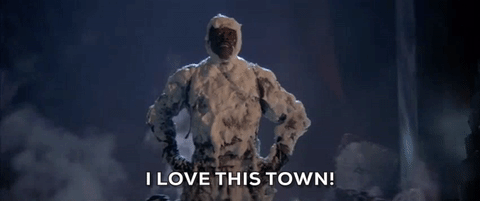Ghostbusters is a perfectly structured film. Desire lines are clear scene by scene. Act breaks are sharp and propulsive. Every payoff is set up early in the film, including Mr. Stay-Puft. The film even bothers to make sure we know why ghosts are appearing at this particular point in human history—the dead rise as Gozer approaches. It’s a wonderful, visceral, hilarious film, with a great soundtrack.
But on a recent viewing with friends, we all mentioned how much heart the movie had, how modern films we’d seen recently seemed heartless by comparison. But what is this strange, ephemeral “heart”? The Potter Stewart test is, as always, unsatisfying—we know it when we see it, sure, but what is it that we’re seeing? Why does Winston’s “I love this town!” at the end strike home, even though the question of whether he loves this town or not is never raised in the movie before this moment?
In short: Ghostbusters is the best comedy ever made about the limits of the Lovecraftian worldview.
Ghostbusters is obviously taking the piss out of horror in general. But while the busters’ typical enemies are ghosts of the Poltergeist persuasion, the Big Bad of the movie, a formless alien god from Before Time summoned by a mad cultist-cum-art deco architect, is basically Lovecraftian. From Gozer’s perspective—or the perspective of the Gozer cultist—human beings are small mammals clustered close to the firelight of their pathetic “reason,” etc. etc. etc. Standard Lovecraftian spiel. The skyscraper (and by extension New York and all human civilization) is the illusion. Scratch its skin and you’ll find a heartless alien reality beneath.
But Gozer loses. And the shape and consequences of his loss (“I thought Gozer was a man?”) undercut the Lovecraftian dichotomy between apparent reality and actual horrifying reality. (“It’s whatever it wants to be.”) In Ghostbusters that horrorscape isn’t the truth either—it’s a mistaken interpretation of an underlying world that’s gross, evolving, playful, social, compassionate, and way more interesting than the dry surface layer.

Bear with me here. We first meet Venkman as he’s conducting a fake test of psychic ability as an excuse to hit on a co-ed. Venkman subjects two students, a young man and woman, to the old “tell me what picture’s on this card that you can’t see” test. Each wrong guess earns the guesser a shock. Venkman indiscriminately shocks the male student, even when he guesses right, and never shocks the female student, who guesses wrong every time—then he flatters the girl by talking up her extensive psychic gifts, and parlays that into a date. Reprehensible, sure, but more to the point, reprehensible in a particularly Lovecraftian way. The test is an illusion. The guy administering the test doesn’t believe it has any value. He’s out for his own advantage, or even just for his own amusement, and his motives are opaque to his victims. The students are flattered or hurt according to his whim, but the world in which they think they’re living—the world in which the test is valid—is an utter fabrication. That’s their circle of firelight. Their very belief in the test protects Venkman, who has ultimate authority so long as they keep playing. This opening scene’s a joking restatement of the Lovecraftian (and Gozerian) horror worldview.
But ultimately, the Lovecraftian dichotomy is shallow and unsatisfying. We find Venkman’s advances on the female student pathetic, not rakishly transgressive. Thank god, Ray pulls Venkman out of this little game and drags him into the real world, in this case the New York Public Library, which for all its neoclassical solidity is being disrupted by a ghost who scatters the imposed order of the card catalog and sprays slime all over the nice dry paper. The ghost is an antic element breaking open this Big Bloodless System. This sequence also demonstrates how incompetent Venkman is in situations where he doesn’t have complete control—he condescends to the librarian who discovered the ghost, and utterly fails in his attempt to communicate with the spirit itself—but he does at least learn that there’s a gross, consequential world out there beyond pointless gamesmanship.
Right after this peek under the covers, we see Venkman caught in a higher-stakes version of the bloodless cruelty game he played on the students—and in this case he’s the victim, having been bureaucratically outflanked. His funding’s cut, and he’s thrown out on the street. Again, we see a basically Lovecraftian situation, where the weaker party’s illusions of fairness or rule-following have no bearing on actual outcomes. But, as a result of their recent experience, Venkman and Ray decide that rather than remaining in the winner-loser world they know, they’ll push one level down—into the gross uncertainty of the ghosts.

This pattern of opting out of traditional dichotomies and spaces repeats throughout the film, and each successful opt-out requires the Ghostbusters to embrace discomfort, awkwardness, and play. When the Ghostbusters buy the firehouse, Venkman’s attempt to negotiate the agent into a lower price is undercut by Ray’s pure enthusiasm for the building. Ghostbusting takes a lot of visual cues from plumbing and firefighting, dirty jobs that deal with gross systems beneath built reality that folks generally try to deny exist—but when the Ghostbusters are called to a high-class hotel, they go in through the front entrance, rather than the tradesman’s door, even though they look ridiculous on the red carpet in their jumpsuits. Each of the three initial Ghostbusters has a wall of doctorates, but even when they have enough success to wear suits and ties, they keep the jumpsuits and rubber gloves. When EPA Guy storms the firehouse to shut off the ghost trap with an electrician and a police officer in tow, what could have been a traditional Ghostbusters vs. Authority conflict becomes a three-way negotiation between EPA Guy, Electrician and Cop, and Ghostbusters, with the Electrician and Cop represented as distinct from either party, and the Ghostbusters appealing not to the professional class (EPA guy) with whom they share more common background, but to the working-class folks (cop & electrician) with whom they’ve come to have more in common. When the Ghostbusters get arrested, rather than playing up the “emasculated middle class dudes in prison” trope, the film shows us prisoners gathering around Egon’s blueprints, genuinely interested in the story being told. On a practical level, even the ghosts themselves, the movie’s core, are neither physical nor ethereal—they’re a slimy in-between.
Then, at the end of the movie, the Ghostbusters are subjected to another version of Venkman’s test. Gozer, the Big Bad, asks them to choose the form of their destruction: another game that exists purely for Gozer’s amusement. They try to refrain from choosing at all, but they can’t—inaction is not an option. Fighting Gozer in his chosen form—Mr. Stay-Puft (a brand icon! talk about bloodless symbols against which we play a game we can’t win!)—doesn’t help them, because their resistance is part of the game of their destruction. Instead they need to attack the game directly, by destroying the system from which Gozer derives his power—in the process making themselves radically vulnerable, in this case to Egon’s prediction of the “very bad” consequences of stream-crossing.

We can chart this same evolving relationship with the world through Venkman’s three instances of personal contact with authority—first, when he buys into the academic system, he’s powerless against the Provost. Second, when he meets EPA Guy, he doesn’t play into the game, so he has a little power, but rather than transcending (or undercutting) the game he fights it—leading to the catastrophic release of the ghosts later. Finally, when the Ghostbusters meet the mayor, Venkman’s ready to deal, and more importantly, to play. He doesn’t impress on the mayor the futility of his (the mayor’s) position, or play for advantage. He offers the mayor an opportunity. Hell, he does more than offer the mayor an opportunity—he offers Lenny an opportunity, addressing the mayor by his first name, as a human being rather than an official.
This, then, is the world-view Ghostbusters offers in place of the Cthonic duality. As in Lovecraft we have a surface world of institutions, with a horror zone beneath—which, if you read human history, is not far from the truth. Many bodies lie buried beneath our marble facades. But if you press through the marble and the rot—which takes work, humility, courage, and a sense of humor—you’ll be able to connect with living breathing human beings.
It’s no accident, then, that the film progresses from shots of New York architecture to shots of New York people. We grow from the opening shot of the New York Public Library to the closing shot of the Ghostbusters emerging into a joyful crowd meant, I think, to represent all New Yorkers (whether or not the casting directors accomplished that is another question entirely). To be even more specific—that opening shot pans down from the New York Public Library’s unpainted neoclassical facade to focus on a stone lion—a powerful symbol, yes, and ominous, but also sort of quirky and weird. What does the lion have to do with ghosts? Until, at the Act III transition, we see a stone hellhound, shot to echo the lion, break open to reveal the actual squicky fleshy hellhound beneath. There’s our Lovecraftian transition. Exterior appearances of classical strength and power hide horribly squamous realities. But, in the film’s resolution, the hellhounds break open again, with exactly the same special effect no less, to reveal Dana and Tully—breathing human beings beneath the squamous stuff that ate them.
As per usual, I don’t claim there are no grounds on which one could take this film to task. (Gozer’s initial appearance plays right into the “Horror is Androgyny” trope, for example.) But it does chart a path from professional denial of (and even participation in) the horrors and weirdnesses of civilization, toward comprehension and defeat of those same forces—passing through the facade city of everyday life and the horror city of Lovecraftian panic to discover the human city beneath.

“I love this town” indeed.
An earlier version of this post was originally published September 2014 on Max Gladstone’s blog for the 30th anniversary of Ghostbusters.
Max Gladstone writes books about the cutthroat world of international necromancy: wizards in pinstriped suits and gods with shareholders’ committees. You can follow him on Twitter.










